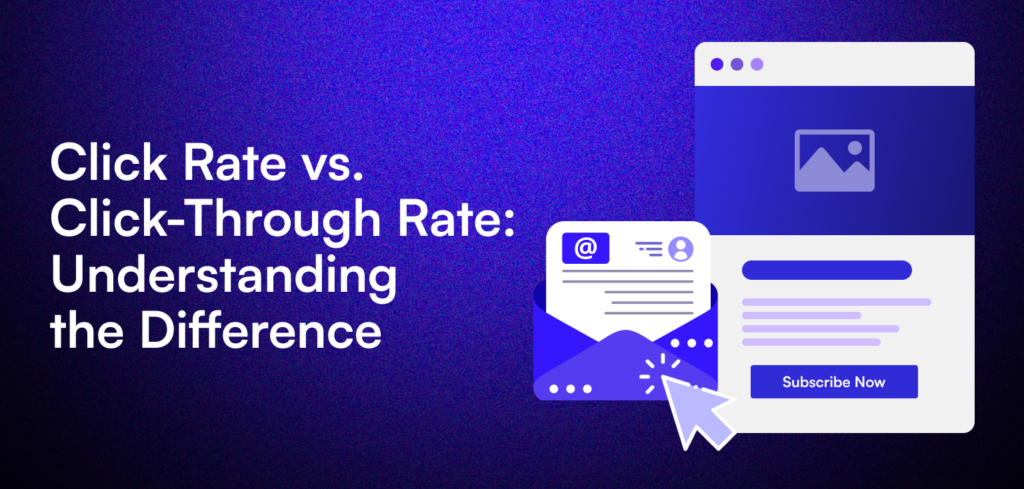Email marketing is, no doubt, a powerful tool for brands to connect with their audience, drive engagement, and ultimately boost conversions.
To measure the success of your email campaigns, it’s essential to understand key metrics like click rate and click-through rate (CTR). Although these terms are often used interchangeably, they actually represent different aspects of email performance.
In this blog post, we’ll dive deep into the distinctions between click rate vs click-through rate, explore their importance in email marketing, and provide best practices for improving both metrics.
What is Click Rate?
Click rate is a metric that measures the percentage of people who clicked, divided by the number of emails delivered. It provides insights into overall engagement and the effectiveness of your email content.
How is the Click Rate Calculated?
To calculate the click rate, use the following formula:
Click Rate = (Total Clicks ÷ Number of Delivered Emails) × 100
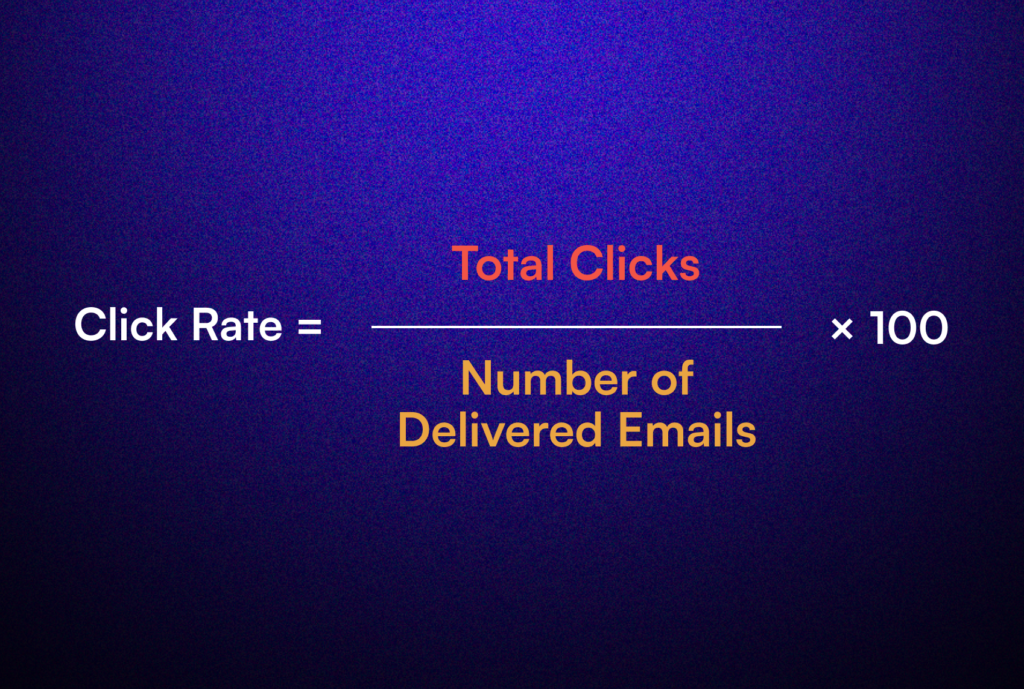
For example, if you send an email to 1,000 subscribers and get a total of 500 clicks to your website or blog, your click rate would be 50%.
The Importance of Click Rate in Email Marketing
Click rate is an essential metric because it shows how engaging your email content is to your audience actually is. A high click rate suggests that your subscribers find your content valuable and relevant, and encourages them to interact with your emails.
By monitoring your click rate, you can identify which types of content resonate best with your audience and optimize your email strategy accordingly.
On the other hand…
What is Click-Through Rate (CTR)?
Click-through rate, or CTR, is a metric that measures the percentage of people who clicked a link in your email out of the people who opened your email.
Unlike click rate, CTR focuses on the unique interactions with your email campaign among those who opened the email.
How is the Click-Through Rate is Calculated?
To calculate the click-through rate, use the following formula:
Click-Through Rate = (Number of Clicks ÷ Total Opened emails) × 100
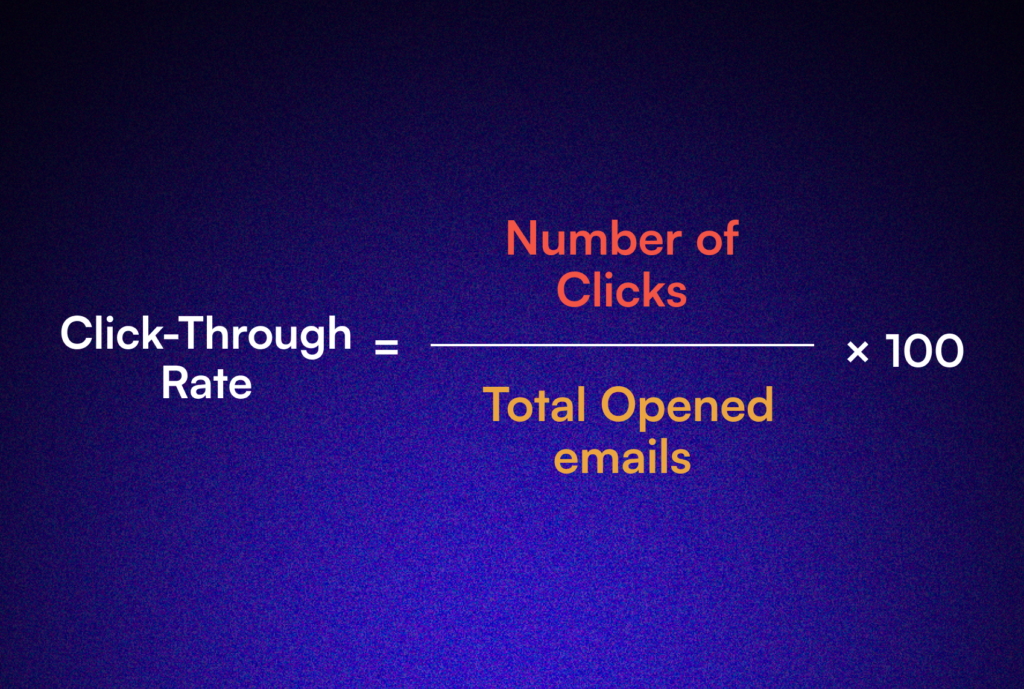
For example, you send an email to 1,000 subscribers and 500 of them open your email; 200 of the openers click on a specific link within the email, your CTR for that link would be 40%.
The formula would be (200 ÷ 500) x 100
Importance of CTR in Email Marketing
CTR is a crucial metric for understanding how effectively your email content drives subscribers to take a desired action, such as visiting your website or making a purchase. A high CTR indicates that your email copy, design, and call-to-action (CTA) are compelling and relevant to your audience.
By tracking your CTR, you can optimize your email campaigns to drive more conversions and achieve your marketing goals.
Key Differences Between Click Rate and Click-Through Rate
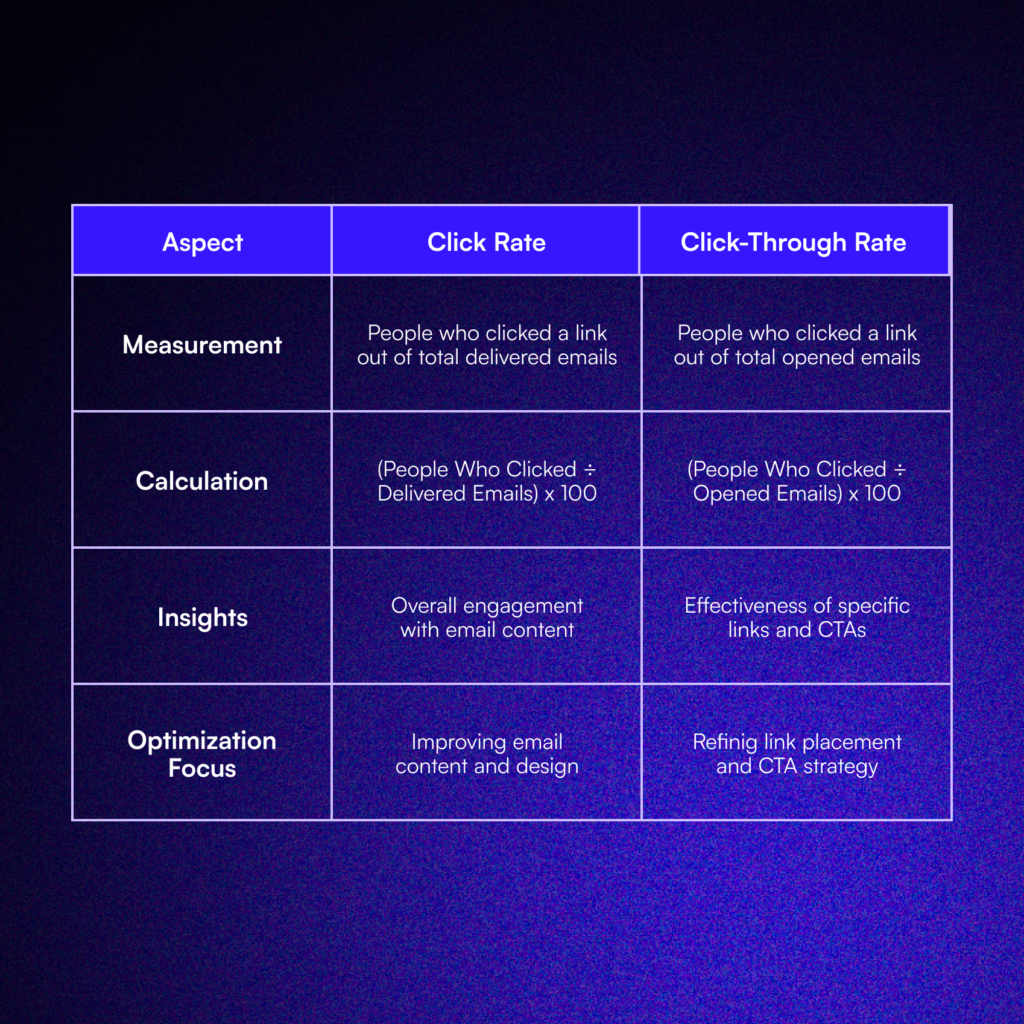
Basis of Measurement
Click rate measures the total number of clicks on all links within an email, while CTR focuses on unique clicks versus your open rate. This distinction is crucial because click rate accounts for multiple clicks by a single recipient, providing a broader view of engagement, while CTR zeroes in on the percentage of openers who clicked on any link within the email.
Impact on Email Campaign Analysis
Click rate offers insights into the overall effectiveness of your email content and design in engaging your audience. A high click rate indicates that your subscribers find your emails valuable and are motivated to interact with them.
On the other hand, CTR helps you evaluate the performance of specific links and CTAs within your emails, allowing you to optimize their placement, wording, and design to drive more conversions.
Click-Through Rate and Click Rate in Action
Imagine you send an email to 1,000 people, 600 of them open.
- Total Delivered: 1000
- Total Opens: 600
- Total Clicks: 300
Click Rate Calculation:
Click Rate = (Total Clicks ÷ Number of Delivered Emails) × 100
Click Rate = (300 ÷ 1,000) × 100 = 30%
Now here’s the Click-Through Rate (CTR) Calculation:
CTR = (Number of Unique Clicks ÷ Total Opened emails) × 100
CTR = (300 ÷ 600) × 100 = 50%
When to Use Click Rate vs. Click-Through Rate
Should you always keep an eye on both metrics? Well… yes. But there are some aspects of your email’s performance that will be better examined by either the Click Rate or the CTR.
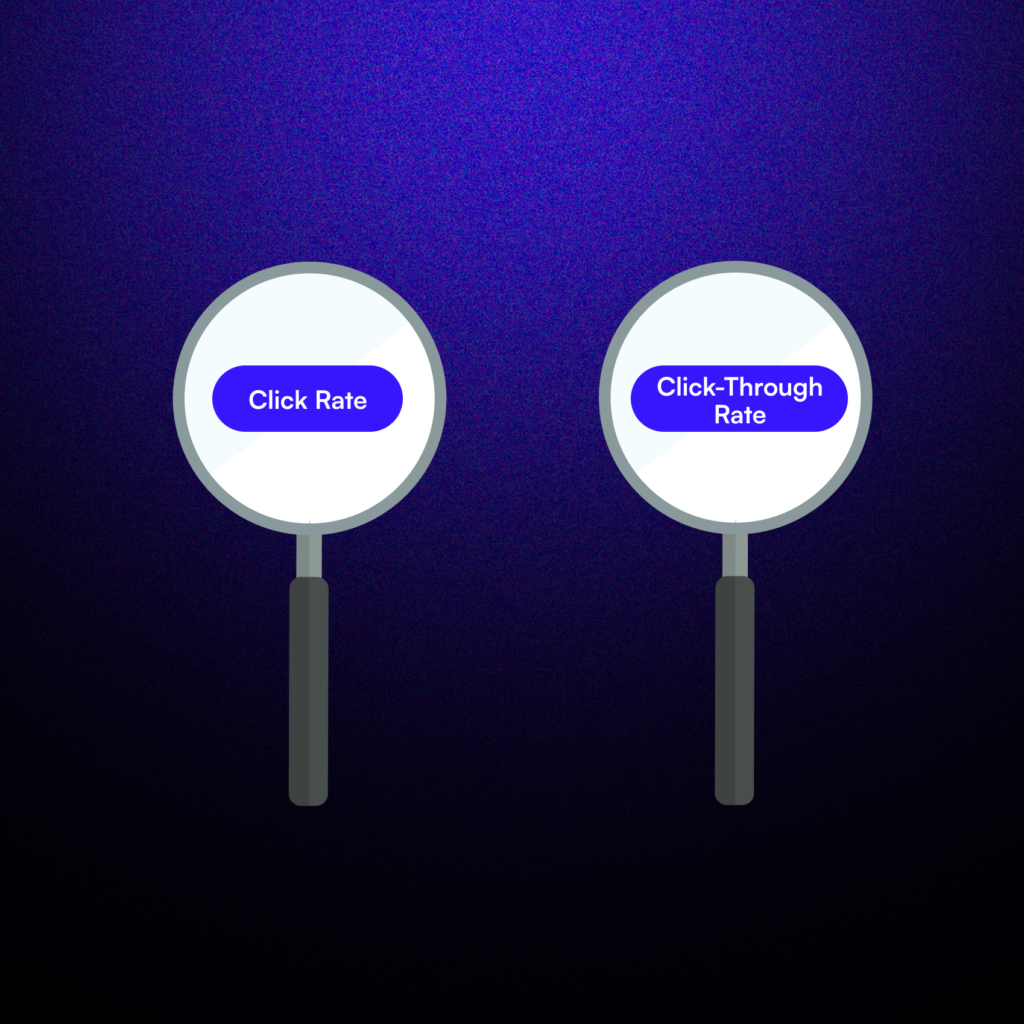
Campaign Performance Analysis
When analyzing the overall performance of your email campaigns, click rate is a valuable metric to consider. It gives you a broad understanding of how engaging your email content is and how motivated your subscribers are to interact with it. When you track click rate over time, you can identify trends and make data-driven decisions to improve your overarching email strategy.
Audience Engagement Insights
Click rate is particularly useful for gauging the level of engagement among your email subscribers. A high click rate suggests that your audience finds your content relevant and valuable, while a low click rate may indicate that your emails are not meeting their needs or expectations. You can also segment your audience based on click rate, so you can tailor your content and messaging to better resonate with each group.
A/B Testing and Optimization
When it comes to refining specific elements of your email campaigns, such as subject lines, CTAs, or link placement, CTR is the metric to focus on. By conducting A/B tests and comparing the CTR of different variations, you can determine which approaches are most effective in driving clicks and conversions. This granular insight allows you to continuously optimize your email campaigns for better performance.
Common Mistakes and Misconceptions
Misinterpreting Metrics
One common mistake email marketers make is assuming that a high click rate always indicates a successful email campaign.
While a high click rate is generally positive, it’s important to consider other metrics, such as CTR and conversion rate to get a complete picture of your email performance.
A high click rate coupled with a low CTR or conversion rate may suggest that your email content is engaging but not effectively driving desired actions.
Overlooking Contextual Factors
Another mistake is interpreting click rate and CTR without considering the context of your email campaigns. Factors such as the type of email (e.g., promotional, transactional, or newsletter), the target audience, and the industry benchmarks can all impact what constitutes a “good” click rate or CTR.
It’s essential to set realistic goals based on your specific context and track your performance over time to identify areas for improvement.
Neglecting Other Important Metrics
While click rate and CTR are important, they should not be the only metrics you focus on. Other key email marketing metrics, such as open rate, bounce rate, unsubscribe rate, and conversion rate, provide valuable insights into the health and effectiveness of your email campaigns.
By taking a holistic approach to email performance measurement, you can make informed decisions and optimize your strategy for success.
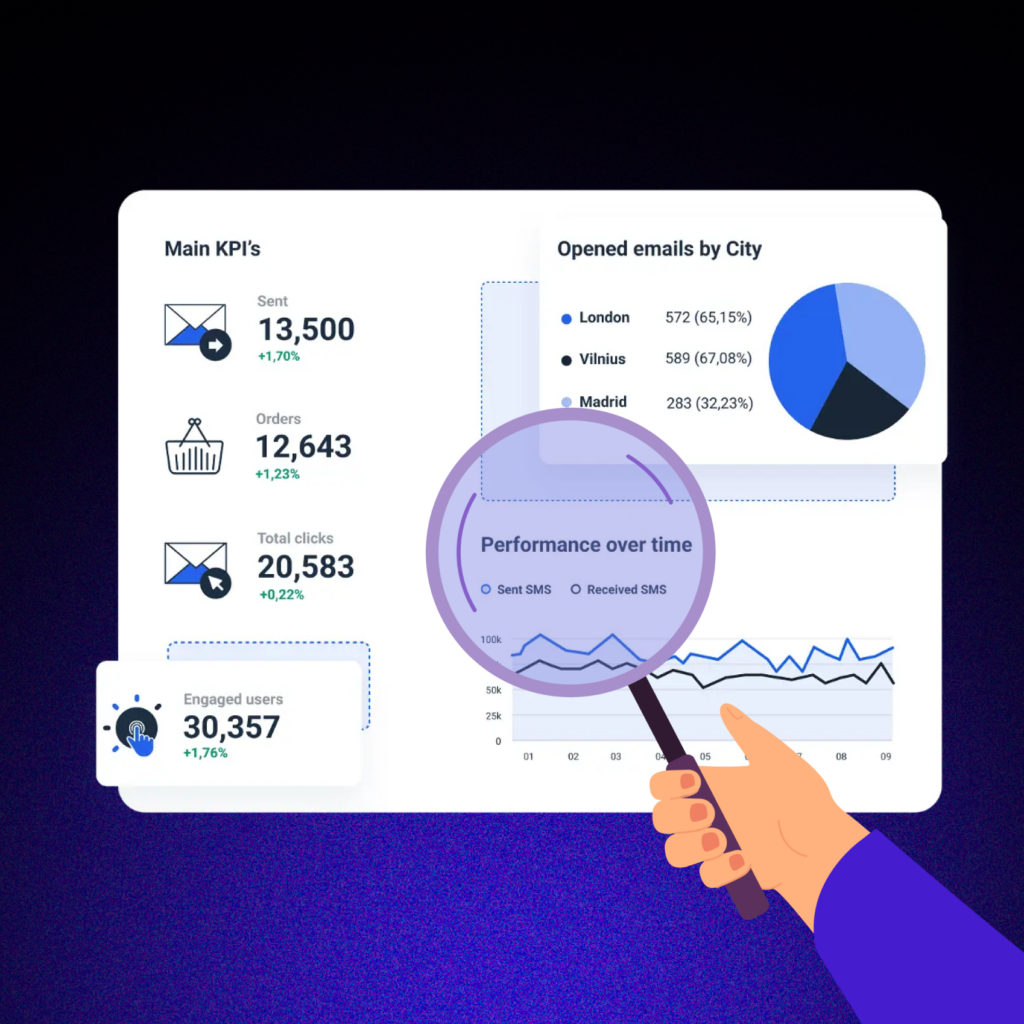
Plus 4 Actionable Tips for Improving Click Rate and CTR
Tip #1: Crafting Compelling Content
To improve both click rate and CTR, start by creating email content that is valuable, relevant, and engaging to your audience. Use attention-grabbing headlines, compelling copy, and clear calls-to-action to encourage clicks and conversions. Segment your audience and tailor your content to their specific interests and needs to maximize engagement.
Tip #2: Optimize Email Design
The design of your emails can have a significant impact on click rate and CTR. Use a clean, mobile-responsive layout that makes it easy for subscribers to read and interact with your content. Place important links and CTAs in prominent positions, such as above the fold or in a contrasting color, to draw attention and encourage clicks.
Tip #3: Personalize and Segment
Personalization and segmentation are powerful strategies for improving email engagement and driving clicks. Use subscriber data, such as demographics, interests, and past behavior, to create targeted email campaigns that resonate with each segment of your audience.
Personalize email content, subject lines, and CTAs to create a more relevant and engaging experience for your subscribers.
Tip #4: Timing and Frequency of Emails
The timing and frequency of your email campaigns can also impact click rate and CTR. Experiment with different sending times and days to determine when your audience is most responsive. You should also be mindful of email frequency, as sending too many emails can lead to subscriber fatigue and decreased engagement.
Always try to strike a balance between staying top-of-mind and respecting your subscribers’ preferences.
So, what now?
Understanding the difference between click rate vs. click-through rate is crucial for effectively measuring and optimizing your email marketing performance. While click rate provides insights into overall engagement, CTR offers a more granular view of how specific links and CTAs are performing.
By focusing on both metrics and implementing best practices for improving them, you can create email campaigns that resonate with your audience, drive more clicks and conversions, and ultimately achieve your marketing goals.
Remember, click rate and CTR are just two pieces of the email marketing puzzle. To truly succeed, it’s essential to take a holistic approach, considering other key metrics and constantly refining your strategy based on data-driven insights.
Read this next: Beyond Vanity Metrics: KPIs for Measuring Email Marketing Success

